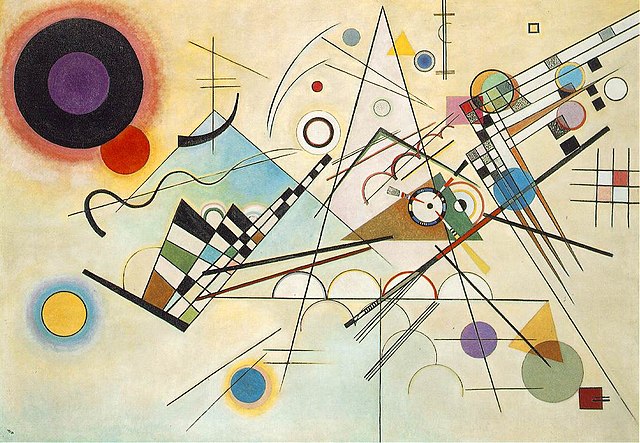 Even before the profound rupture of the Great War and the political revolutions that followed, a revolution in culture had taken in the first decade of the twentieth century. And in the visual arts, almost no one was so transformed by that revolution as Wassily Kandinsky. He was born in Moscow in 1866 and studied art in Odessa at the Grekov Art School. He then moved on to study law and economics and only returned to art in his 30s. Kandinsky’s early works are beautiful in the warmth of their colors, but conventional. As he began to think about the challenges of modernism in music as well as art, Wassily Kandinsky gradually became even more daring. The outlines of structures in his paintings began to melt. From 1911 onward, he filled entire canvasses with colored abstractions, and was among the first to produce purely abstract art. From the Concrete to the ConceptualThe challenge faced by all artists in an era where a camera could reproduce scenes more accurately than a painting was to think again about the purpose of their art. For Kandinsky, the solution to the crisis of traditional art was to understand that art functions on two levels simultaneously, it influences both the senses and the mind. Once he had decided to investigate the effects of abstract painting on the mind, he opened the door to a revolution. Spending hours and hours experimenting with the impact of shape on color on his inner being, Wassily Kandinsky came to realize that even apparently simple geometric shapes could carry a powerful aesthetic impact to the viewer. Wassily Kandinsky and the BauhausThe Bauhaus was an avant-garde art school that strove to unite arts, crafts and architecture in a revolutionary and modern fashion. Kandinsky was invited to join the school and there (1922 – 1933) he perfected his technique. His paintings from this period are stunning, in that they use carefully chosen blocks of color to evoke an emotional response in the viewer and selected shapes to challenge the human desire to make sense of patterns. Wassily Kandinsky was among the practitioners persecuted by the Nazis, who included his work in the list of ‘degenerate art’. He was forced to flee and moved to France, where he lived and worked until 1944. “My Six-Year-Old Can Paint Like That…”The case against Wassily Kandinsky, as against many other modern artists, is that anyone can paint in his style, even children. Yet contemplation of Kandinsky’s works evokes such strong responses that there must be more to them than the superficially playful interaction of color and shape. And there is. Wassily Kandinsky himself explained the issue in his 1926 book, Point and Line to Plane. The subjective effect upon the inner mind of the viewer even of points and lines can be profound. The manner in which a line is placed, the angle it makes, is enough to create meaning. A horizontal line evokes the ground on which a person moves, while a curved line suggests powerful forces are at work. Only someone who spends decades mastering color and contemplating on the spiritual and unconscious associations of geometric shapes can produce such masterful paintings as those of Wassily Kandinsky.
0 Comments
Leave a Reply. |


 RSS Feed
RSS Feed
